by Richard
Hyman
(click on photos to enlarge image)
THE USE OF COINS IN PUNCH OR TODDY LADLES
Dorothea Burstyn's article on punch ladles
(#67 Let’s drink and be merry - a study about punch ladles)
mentions a fascinating sub-set
with inset coins.
Can we use the coins better to date the ladles, why were the
coins used, what coins were used?
I'll first offer my hypotheses and some observations on
collecting. I'll follow with opinions solicited from reputable
collectors and dealers in silver and coins.
Georgian coins:
The standard reference for British coins is:
Coins of England and the United Kingdom
by Philip Skingley (Editor) Publisher: Spink & Son Ltd, 2007 -
ISBN 1902040821
The Georgian kings of England were:
George I (1714 - 1727)
George II (1727 - 1760)
George III (1760 - 1820)
George IV (1820 - 1830)
The three metals used are gold, silver and copper. We need
only concern ourselves with the precious metals. I cannot
definitively state copper coins would not have been used, but it
seems, unless there were some overwhelming personal reason,
there’d be no point setting base within precious metal.
As far as I know, the coins of the period are dated but not
denominated. It appears size and the verso design are the
governing factors, not surprising since much of the population
was illiterate. I find this confounding because the catalog does
not give clear size indications. Lest we feel sanctimonious,
look closely at U.S. coinage - no numbered value appears. If the
bearer cannot read the lingua franca, lots of luck.
I think identifying the coins employed adds to the description
of the ladle, and gives some possible indication as to value,
especially if they are gold, with the caveat a coin thus set
would be considered worthless to numismatists. Since there seems
to be no record of the quantities issued, the catalog value of
the coin appears related to the rarity and provides some clue as
to the likelihood of particular dates appearing.
The availability of precious metal is related to the issuance of
coins and, incidentally, the weight and amount of silver objects
(note 1):
In 1723 a large quantity of silver was brought to the
mint by the South Sea Company to be made into coin…The gold
coins of George II were given new reverses….This finally stopped
the fraudulent gilding of silver coins, a practice which was
very common during this period…In 1744 Admiral Anson returned to
England…with an immense quantity of bullion…Most of Anson’s
treasure consisted of Spanish-American silver coin, though there
was some gold…After 1745, however, it appears that the supply of
silver from home sources failed due to the exhaustion of the
mines…there were further issues of silver coin in 1750, 1751,
1757, 1758…Owing to the increasing difficulty in obtaining
silver, and consequent increase in its price, the 1758 coins
were the last silver coins issued in any quantity for nearly
thirty years…[In George III’s reign] even gold became so scarce
during the Napoleonic Wars that a paper currency more or less
took its place…The issue of guineas was interrupted in 1797
owing to the hazards of importing gold bullion from overseas
during the Napoleonic Wars…Owing to the shortage of gold,
bank-notes were declared legal tender in 1797 for any amounts
over one pound, and so from that time until the great re-coinage
of 1816/17, the country’s finances were run more or less on
paper currency. Owing to the high price of silver no silver
coins were issued during the earlier part of George III’s reign
except for small amounts of “Maundy” coins and a very limited
quantity of shillings dated 1763…No other silver coins were
struck until the year 1757, when, following a temporary fall in
the high price of silver, a very large number of shillings and
six-pences were issued…A number of private silver tokens began
to appear in 1811, being issued by local authorities, private
traders and bankers…Though the issuing of these tokens was a
breach of the authorities took no action against the issuers
as they did serve some useful purpose…in 1813, all private
silver tokens were prohibited.
Most of the people in Georgian England never handled
banknotes. The wages for the servant classes for an entire
quarter was usually less than the smallest denomination notes.
The coins, as follows, were used for nearly all transactions
until the wars with Revolutionary France caused a hard currency
shortage.
Not all coin denominations were minted every year especially
after 1797 when the bullion needed for coins were also needed
for the war efforts against Revolutionary France. This bullion
shortage continued through the wars until after Waterloo
(note 2).
The relation of the date of the coin to the date of the
ladle:
We can take the date of the coin as a terminus post quem,
but how long after might the ladle date? Being mindful of the
erratic issuance of coinage, we can locate the next issuance but
that only tells us fresh coins were unavailable during a certain
gap.
Some speculate the ladles are close to the date of the coin. One
dealer writes:
By and large it seems to be accepted in auction rooms
that this type of ladle is contemporary to the date of the
coin…Of course destroying the coin of the realm in this manner
was illegal so no hallmarking could be done and without
hallmarks it is impossible to put an exact date on it.
My experience with auctioneers is mixed; Christies, sure,
but ordinary auctioneers? I think it’s more likely the ladle
manufacture would be near the coin date but not conclusively. In
the absence of other cues the auctioneer's assumption is useful.
But, coins remain in circulation a long time, might be stored
and used later, and as noted above there were long periods of no
new coins.
Maybe the coin would reflect some personal connection with the
owner: People buy silver with their initials. I can imagine
someone presenting a smith with a coin dating from his mother’s
natal year and asking to imbed it, or a signal event in the
nation’s history, or a good luck coin.
I think dating might rely more on characteristics of the ladle
itself (see Ms. Burstyn’s article). While many ladles are not
dated, and with coin ladles a case is made that it’s not to
offer evidence to the Crown, an absence of stamps is common in
these as well as other articles. There are, as well, examples of
hallmarked coin ladles. I have been unable to find the statutes
governing destroying coinage so cannot have an opinion.
Here’s a ladle from my collection, not a coin ladle, but
instructive as to dating. The format and repousse appear 1750 -
1775 (always acknowledging retardataire possibilities). We have
a satisfying conjunction of elements: design, lettering style
and marks. A 1776 date stamp, the stamp of Thomas Shepherd (1st
mark 1769, 5th mark 1786), and an inscribed date of 1779 in
period style. Doesn’t get any better than that.
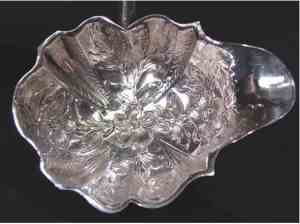 |
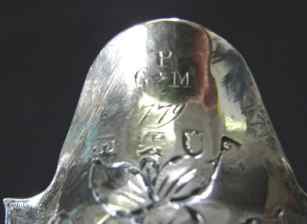 |
A 1776 silver ladle (no coin)
|
detail
|
Some examples of coins in ladles: silver, gold-plated
silver, gold
It's been said smiths used coins when the value of the
silver in the coins exceeded the face value and was higher than
market silver, and that smiths beat coins into bowls. The
central coin would be unbeaten filler. It’s incontrovertible
that coins were beaten into bowls because some bowls retain the
coin impress.
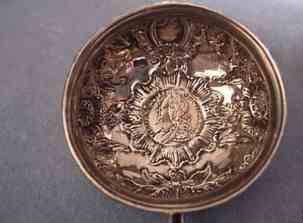 |
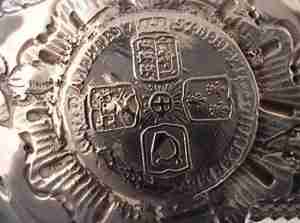 |
A 1757 silver shilling ladle
|
detail
|
A 1757 silver shilling ladle. It would be far easier to
convert a quantity of coins into stock. Imagine what would be
involved in beating a round coin to form a bowl, cutting a hole
and soldering another coin in the center. Further, the thickness
of the central coin would be greater than the surround, and thus
more valuable. If the goal is to minimize cost, why not beat
that out as well? I suspect while using coins for raw material
occurred it's far more likely the coins were a decorative
element, a practice that continued until the current era, I
suspect through intervals where arbitrage was not a
consideration.
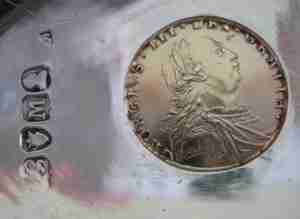 |
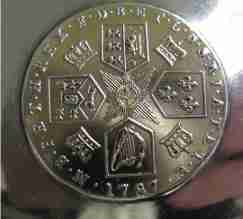 |
A 1787 gold-plated silver shilling ladle,
fully hallmarked for 1807
|
1787 gold-plated silver shilling
|
A 1787 gold-plated silver shilling ladle, fully hallmarked
for 1807 (from my collection). The maker’s mark is
undecipherable. This is an example that challenges the assertion
the use of coins in Georgian ladles was illegal. A fuller
discussion of this controversy follows.
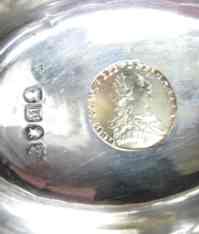 |
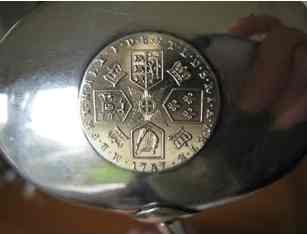 |
Another 1787 gold-plated
silver shilling ladle,
fully hallmarked for 1807
|
1787 gold-plated silver shilling
|
A second example of a fully hallmarked coin ladle. The date
stamp is for 1807, the maker’s mark obscured. Clearly by this
time makers were stamping their coin-embedded labels. It may be
that the laws against using coins thusly never existed, weren’t
enforced, or were repealed by this time.
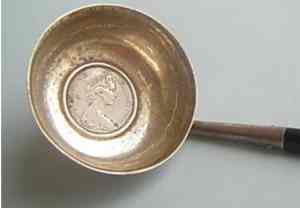 |
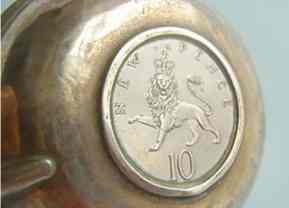 |
Elizabeth II, hallmarked Sheffield 1976
|
10 New Pence
|
Elizabeth II, hallmarked Sheffield 1976. In this case we
have a coin captured in a ladle that’s fully hallmarked. May we
assume the manufacturers of this label knew there was no breach
of the law? Where does that leave the injunction against
defacing currency? Did it exist? If so, was it rescinded?
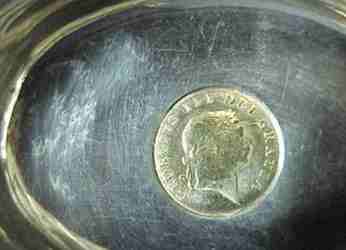 |
An 1808 gold half guinea mis-identified as
a "solid gold George III shilling coin"
|
Gold coins are far more valuable than silver coins, and
discredit the theory of using coinage to save raw material cost.
In this case an 1808 gold half
guinea was mis-identified as a "solid gold George III shilling
coin": Silver shillings were sometimes gold plated by
individuals for enhancement or fraud (note 3).
A coin dealer writes, "I have seen many of these shillings
that were gilded because they were the same size as a gold
guinea". Another coin dealer, "Coins of this period were
quite often Gilt, and used as good luck charms, or keepsakes".
The plating may be pristine or worn. Sometimes the lighting may
make silver appear gold, but when it's embedded in silver, as in
this worn example, the distinction is obvious
(note 3)
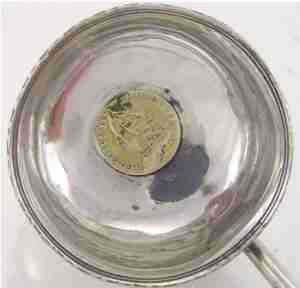 |
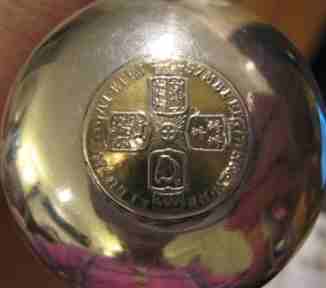 |
1757 gold-plated shilling
|
|
1757 gold-plated shilling, ladle in my collection
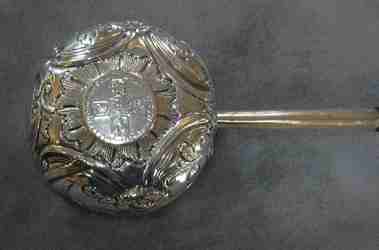 |
Another example
(date unknown)
|
An example of an advertisement where the photograph is too
small to read the date on the coin
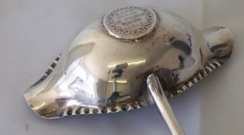 |
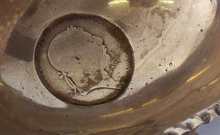 |
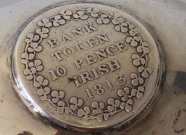 |
A ladle incorporating an 1813 Irish token
|
|
|
An example of ladle incorporating an 1813 Irish token
What to look for in buying coin ladles
Condition is always important. These objects may have been
in use for hundreds of years. Where might stress and have
contact occurred?
Points of special focus include:
1 Socket joint damage may appear on either side of the
connection to the bowl, evidenced by subsequent solder. If the
solder is clean, solid and well done, I don’t find this
objectionable. The interior joint area may be covered with a
decorative cut piece. If there’s no cut piece check it’s not
missing, as revealed by evidence of solder and disrupted
patterning.
2 The handle should fit securely into the socket. Note
how in this illustration the handle appears wider than the
socket where they meet and is shorter than the norm probably
indicating it has been cut down and reset
It isn’t unusual that the handle becomes loose. I repaired a
detached baleen handled ladle, cutting out the silver rivet,
grinding and scraping out the remnants of baleen in the socket,
and reshaping the butt of the handle. I could have used a full
dental kit.
3 As with the socket and stem, the cap should
be secure (not all ladles have caps).
4 The handle may be of wood, baleen, ivory or other bone.
An expert writes:
The "horn" handles they talk about in Canada are almost
certainly baleen. Not sure what kind of cow had a horn that
could be manhandled into a twisted ladle handle. Perhaps "horn"
is a way of avoiding CITES restrictions on international baleen
sales. Most if not all British baleen of the 18th-century came
from the seasonal Greenland Right Whale (Bowhead) fishery of the
eastern arctic. Baleen strips were extracted, bundled, and taken
home for further refinement.
Look for unsightly, unstable cracks and any evidence of
replacement. Baleen, which must be twisted into shape may revert
and cannot easily be reconstituted. As with other objects that
take vigorous use, e.g. fish slices, it’s possible the handle is
a replacement as well as being cut down.
5 Monograms and crests can be removed, or removed and
replaced by later owners. Erasure results in thinning of the
silver. You may see awkward patches inside or out, solder,
scratches. Sometimes the patch may be skillfully incorporated
into a cartouche, more often it is too apparent. Breathing over
the area may reveal changes in condensation patterns. Subsequent
changes usually devalues a piece, but if it’s skillful I am not
troubled.
Finally, dealers may blithely advise that damage can easily be
repaired by a competent silversmith. The only reputable
silversmith I know is an hour and one half round trip. He will
conjecture, but not firmly estimate, on the basis of photographs
meaning I’d have to buy an object before I’d have a reliable
idea of the repair cost. Further, I would not know if the repair
would be acceptable to me. The rough estimates I’ve solicited
have been more than the cost of the object. I would only
entertain a repair if I could not do without something and its
value was far greater than that of the contemplated repair.
ENDNOTE
(note 1) Peter Seaby, The Story of the English Coinage,
(London: B.A. Seaby, Ltd., 1952), pp. 87-97.
(note 2) British Silver Coins 1662-1946 at
http://www.coinsite.com/content/Articles/BritainSilver.asp
(note 3) Peter Seaby, p.87.
COMMENTS AND USEFUL LINKS
From a dealer:I try not to go by a date on anything unless
it states the date it was made. The reason is the date
could have been a certain period of time that something
significant had happened in this person's life. You would be
surprised how many people buy something because it is their or
or their family's birthday, wedding, etc.
From a dealer:
It would seem to be a lot of work to beat out a ladle from a
coin rather than use fresh silver, It is likely that this would
only be done if the wholesale silver price was greater than the
face value of the coins in your pocket, that is it was cheaper
to use coins than to buy the same weight in new silver. Of
course destroying the coin of the realm in this manner was
illegal so no hallmarking could be done and without hallmarks it
is impossible to put an exact date on it.
From a dealer (I have seen this act referenced but have been unable
to find the text. I note there is a deal of information always
sloshing around the antiques world. Some of it is verifiable.):
Under the Silversmiths act of 1739 punch-ladles were exempt
from being disfigured with hall-marks if they were so richly
engraved, carved or chased... as not to admit of an assay to be
taken of, or a mark to be struck thereon without damaging,
prejudicing, or defacing the same, or such other things as by
reason of the smallness or thinness thereof are not capable of
receiving the marks... and not weighing ten penny weights of
gold or silver each
Coins of the Realm: http://www.georgianindex.net/banking_economics/regency_coin.html
British Silver Coins 1662-1946: http://www.coinsite.com/content/Articles/BritainSilver.asp
|
|
 ASSOCIATION OF SMALL COLLECTORS OF ANTIQUE SILVER
ASSOCIATION OF SMALL COLLECTORS OF ANTIQUE SILVER
















